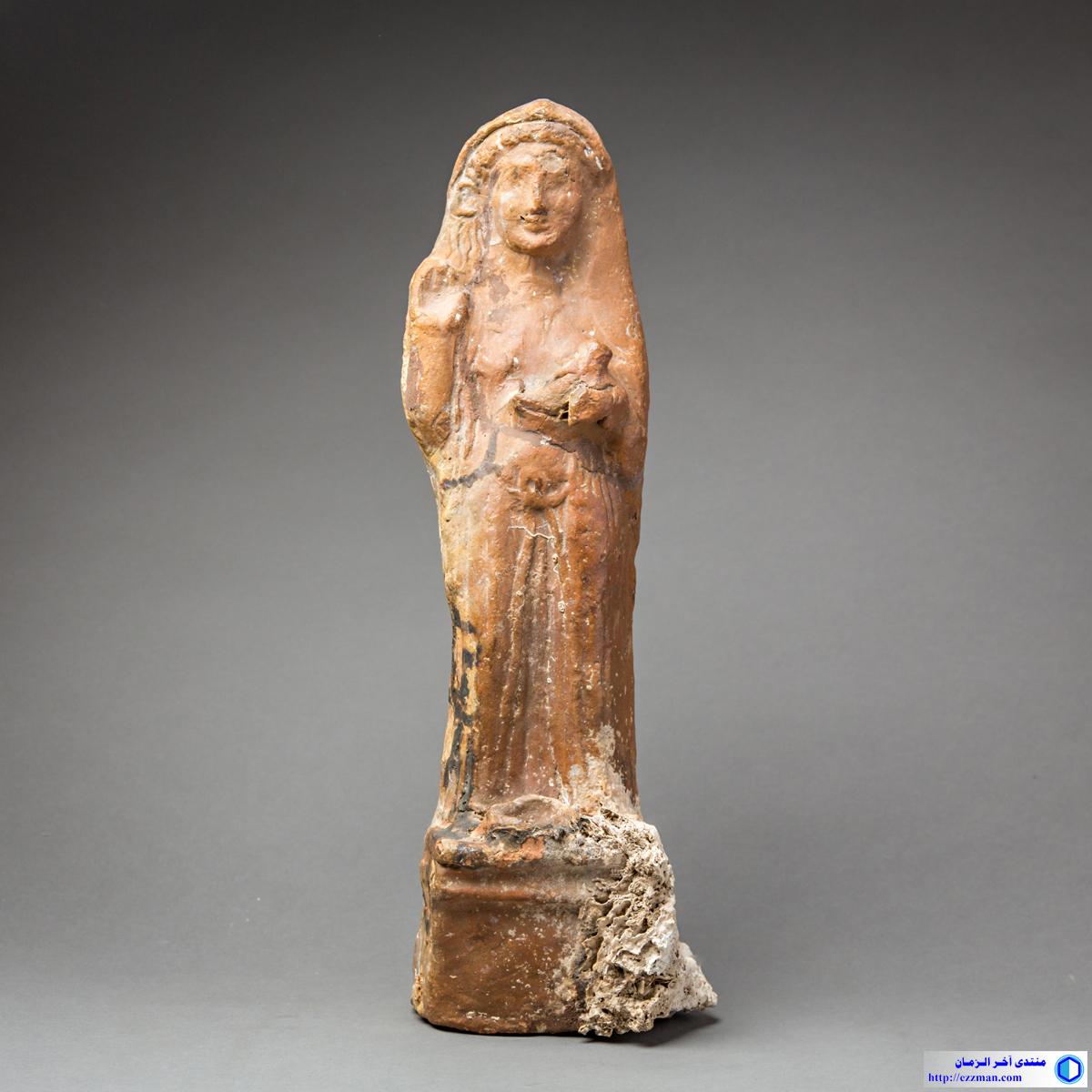
Phoenician Votive Figure - DV.514
Origin: Lebanon
Circa: 600 BC to 500 BC
Dimensions: 16.5" (41.9cm) high
Collection: Biblical
Medium: Terracotta
Description This stylishly-modelled ceramic sculpture is a votive figure from the middle of the first millennium BC, and represents a deity in the Phoenician pantheon. It is unusual in terms of detailing and styling. It depicts an elegantly-dressed woman standing on a quadrilateral base with straight sides and an upwardly-sloping anterior aspect, and decorated with a raised border. The figure’s silhouette is largely the outline of the long gown that reaches from the apex of the head to the ground. Within there are details such as a well-rendered tie belt that indicate another garment (probably a tunic) concealed beneath. Detailing of the garments is exquisite, with folds and drapery rendered with great care. The hair is gathered into a solid layer beneath the robe’s apex, with some fronds escaping to the figure’s right side. The stomach and breasts are fairly prominent although the position of the figure is not as “bold” as most fecundity-linked pieces. The fertility associations of this piece are reinforced by the child she is carrying on her crooked left arm, which appears to be breastfeeding from her. The other hand is upraised in what is generally assumed to be a gesture of benediction. The face is elegant and sensitively-rendered, with a long nose, a pursed mouth set in a half-smile, a strong chin and moulded cheeks. The rounded back of the piece is almost completely plain, implying that it was always meant to be viewed from the front rather than in the round, which is appropriate for figures destined for shrines. The piece retains some calcareous concretions from its long interment in the Mediterranean. The Phoenicians were one of the most important civilisations of the ancient world, and flourished from around 1500 to 300 BC. Their world was centred on Northern Israel, Lebanon and Syria, while their sphere of conquest and influence extended throughout the Mediterranean and even beyond the Pillars of Hercules (the Straits of Gibraltar) and into the Mediterranean-Atlantic. Their power was due primarily to their mastery of seamanship – which they developed to a whole new level during their pre-eminence – and extremely well-organised administration which was strengthened by extensive use of the alphabet. Indeed, it was the Phoenicians who introduced the alphabet to the Greeks, who in turn passed it onto the rest of the Western World. They were essentially Canaanites, to whom they were identical in sociocultural and material terms, the only difference being the massive range over which their cultural remains and heritage can be found. Phoenician society was comparatively stable when compared to the changeable fortunes of other Eastern Mediterranean cultures, primarily due to its broad royal, political and religious foundations. The town of Byblos became a major hub for trade all over the Fertile Crescent, followed by Tyre and Sidon; overseas territories notably included Carthage (founded 814 BC), but they either took over or culturally dominated trading ports from Cyprus to Malta, Spain, Portugal and Sardinia. They traded in purple dye (“Tyrian Purple”), textiles, luxury ceramics, silver, tin (with England) and glass, explored down the west coast of Africa as far as the Gulf of Guinea, and may even have circumnavigated Africa in around 600 BC.
Their artistic output is usually on a small scale – enabling it to be easily transported and traded – and made of high-value materials such as glass and precious metal. Phoenician styles are largely derivative, being informed by sources as varied as Cyprus, Egypt, Assyria and Greece, and has been described as an amalgam of pre-classic models and perspectives, often with regionalised local stylistic variants. The use of ceramic figures seems to have been religious in origin, with shrine figures (or baetyls) depicting a wide range of the deities and legendary figures from Mediterranean mythology. Clay tableaux show these figures being displayed in niches, worshipped at a familial or group level, and they were also sometimes interred with the dead. Depictions range from the classical-naturalistic to the schematic or even grotesque. Specific members of the pantheon include Baal (or Baal-Hammon, to whom children were sacrificed), Eshmun (god of healing and the arts), Melqart (the Phoenician equivalent of Poseidon/Neptune) Bes (an Egyptian household god resembling an ugly dwarf), Tanit (the patron goddess of Carthage) and Astarte (an indigenous Phoenician goddess). Various other deities cannot be specifically identified. It is notable that the gender bias is very strong towards goddesses. Hand positions are believed to reflect different moods or intentions. The significance of individual gods or figures cannot be ascertained in most cases. As with most societies, any figure with greatly exaggerated sexual characteristics (or if pregnant, or carrying a child) is usually associated with fertility, although most figures are likely to represent personages whose significance has been lost to us.
The current piece was recovered from the floor of the Mediterranean; the manner in which it and associated pieces were found suggests that it might have been part of a naval shrine aboard the doomed vessel, although it is also possible that it was being taken to a Phoenician outpost in order to form part of a shrine for a prosperous household. It is a beautiful and sophisticated piece, and a potential star attraction of any serious collection of the genre.
Moscati, S. (ed.). 1988. The Phoenicians. John Murray Publishers, London. - (DV.514)